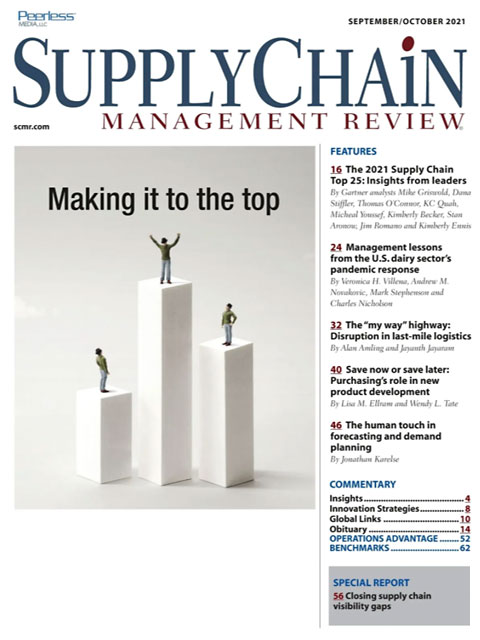Sorry, but your login has failed. Please recheck your login information and resubmit. If your subscription has expired, renew here.
September-October 2021
This time every year, we publish Gartner’s Top 25 supply chains, the annual list of the supply chains that have made it to the top, a list that now also includes 5 Masters, or companies that have consistently outperformed year after year. You can read the article in this issue, along with the web exclusive material we publish on scmr.com, to find out what it takes to become a supply chain leader. Browse this issue archive.Need Help? Contact customer service 847-559-7581 More options
Regulatory mandates, investor demands and consumer sentiment are compelling organizations to deliver on their sustainability promises. To that end, nothing is more vital than dispelling the misconception that sustainable operations always cost more. In truth, no such trade-off is required. Organizations can operate cost-effectively and sustainably.
For example, we helped a major consumer packaged goods company redesign its supply chain to reduce overall miles traveled by 11%. The change trimmed 10% from $250 million in supply chain costs, while also reducing the company’s carbon footprint by 6,700 metric tons of carbon dioxide emissions. Over a decade, that’s equivalent to planting 110,000 trees, or creating more than five Central Parks.
The formula for concurrently lowering your costs and carbon footprint is strikingly simple.
- Measure the waste in what you do.
- Calculate the environmental impact associated with that waste.
- Pinpoint and pursue actions to minimize waste, cut costs and reduce your carbon footprint.
Applying this formula, however, requires a willingness to rethink your fundamental assumptions, coupled with coordinated expertise and sustained collective effort.

This complete article is available to subscribers only.
Log in now for full access or start your PLUS+ subscription for instant access.
SC
MR
Sorry, but your login has failed. Please recheck your login information and resubmit. If your subscription has expired, renew here.
September-October 2021
This time every year, we publish Gartner’s Top 25 supply chains, the annual list of the supply chains that have made it to the top, a list that now also includes 5 Masters, or companies that have consistently… Browse this issue archive. Access your online digital edition. Download a PDF file of the September-October 2021 issue.Regulatory mandates, investor demands and consumer sentiment are compelling organizations to deliver on their sustainability promises. To that end, nothing is more vital than dispelling the misconception that sustainable operations always cost more. In truth, no such trade-off is required. Organizations can operate cost-effectively and sustainably.
For example, we helped a major consumer packaged goods company redesign its supply chain to reduce overall miles traveled by 11%. The change trimmed 10% from $250 million in supply chain costs, while also reducing the company’s carbon footprint by 6,700 metric tons of carbon dioxide emissions. Over a decade, that’s equivalent to planting 110,000 trees, or creating more than five Central Parks.
The formula for concurrently lowering your costs and carbon footprint is strikingly simple.
- Measure the waste in what you do.
- Calculate the environmental impact associated with that waste.
- Pinpoint and pursue actions to minimize waste, cut costs and reduce your carbon footprint.
Applying this formula, however, requires a willingness to rethink your fundamental assumptions, coupled with coordinated expertise and sustained collective effort.
SC
MR


Latest Supply Chain News
- Few executives believe their supply chains can respond quickly to disruptions
- Technology’s role in mending supply chain fragility after recent disruptions
- Tech investments bring revenue increases, survey finds
- Survey reveals strategies for addressing supply chain, logistics labor shortages
- Israel, Ukraine aid package to increase pressure on aerospace and defense supply chains
- More News
Latest Podcast

 Explore
Explore
Business Management News
- Few executives believe their supply chains can respond quickly to disruptions
- Technology’s role in mending supply chain fragility after recent disruptions
- Survey reveals strategies for addressing supply chain, logistics labor shortages
- How CPG brands can deliver on supplier diversity promises
- How S&OP provides the answer to in-demand products
- AI, virtual reality is bringing experiential learning into the modern age
- More Business Management
Latest Business Management Resources

Subscribe

Supply Chain Management Review delivers the best industry content.

Editors’ Picks






